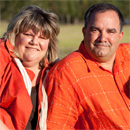Questioning Cardio for Weight Loss?
Q: I’ve heard you mention that you don’t need tons of cardio to burn
stubborn abdominal fat. Okay, I can live with that, but you’ve also said
that it isn’t absolutely necessary to perform direct ab work either. What
gives?
A: If you want to build a serious set of abdominals, routinely perform the
following exercises and their variations: squats, deadlifts, chin-ups, and
standing military presses. These multi-joint movements require a strong
contribution from the abdominals to stabilize the core, particularly when
heavy loads are used. It is not uncommon to hear clients complain of
abdominal soreness a day or two after performing multiple sets with a
decent weight of the chin-up or standing military press exercise – the ab
prestretch will tap into fibers you never thought existed! And remember,
your abdominals act as a natural girdle, or weight belt if you will, when
performing all exercises, particularly squats and deadlifts. These
muscles act as a bridge between your upper and lower body and are
heavily recruited as stabilizers.
Sure, isolation exercises like pullovers, curls, and even triceps
pressdowns also require a good degree of core stability; however, the
loads used are relatively low compared to the big 4 mentioned above. In
fact, according to Siff & Verkhoshansky, isolation becomes virtually
impossible if large loads are used, and in many cases, the tension
developed in the stabilizers will equal or even exceed that of the prime
movers!* So, you see, the abdominals can be trained quite effectively as
stabilizers – the physiques of top Olympic weightlifters will attest to that.
*Siff, MC, Verkhoshansky, YV. “Supertraining (4th Edition).” Denver, CO:
Supertraining International, 1999. (pg. 241)
Q: I am still very much confused regarding cardio intensity. One book
says keep it low intensity (i.e. 60% of MHR) and go for distance; another
keep it high intensity (80% or more) and go for as long and hard as you
can. The goal is to burn fat. Each book has great arguments for their
approach. Which is accurate?
A: The second approach is far more effective for burning fat. Without
getting into a huge discussion about this, here’s how things work in a
nutshell.
At a lower intensity, your body prefers fat for fuel. Yes, this is true, but
two things generally happen:
1. After awhile of doing this type of activity, your body adapts by actually
laying down fat (you heard me right) to become more efficient at the
given task and this usually occurs in the lower body, and
2. A higher relative amount of fat is burned during low intensity cardio
but a greater absolute amount is burned with higher intensity cardio and
in less time.
Other things to consider are: a) the EPOC (excess post-exercise oxygen
consumption) is greater for a longer duration following higher intensity
work; in other words, you’re metabolism is much higher for a longer
period of time post-workout with high intensity cardio, and b) higher
lactate levels exist with high intensity cardio. So what you may ask? Well
there is a direct correlation with lactate and GH (Growth Hormone) and
GH is a potent fat-burner.
Bottom line: with regards to burning fat, do higher intensity work in the
form of interval training and you’ll get great results.
John Paul Catanzaro is a certified kinesiologist and professional fitness
and lifestyle consultant with a specialized honours Bachelor of Science
degree in Kinesiology and Health Science. He owns and operates a
private gym in Toronto, Ontario providing training and nutritional
consulting services. For additional information, visit his website at
www.BodyEssence.ca
or call 416-292-4356.
- DON'T MISS
- Weight Loss Tip #12: How Starving Your Body Can Make You Gain Weight
- How to Burn Pure Fat and Lose Weight More Quickly
- Six Secret Tips That Can Help You Lose Weight Fast
- Low Fat Diets Don’t Make You Fat
- Do Low Carbohydrate Diets Lead to Weight Loss Success?
- Weight Loss? 2 Skills You Need
- Can A Raw Food Diet Help You Lose Weight?
- Burning Fat While Keeping Your Muscle
- Zone Diet Weight Loss Program
- 7 Weight Control Habits




